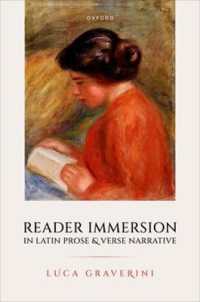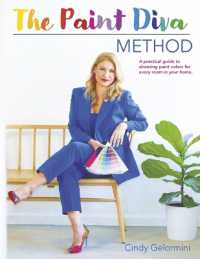- ホーム
- > 洋書
- > 英文書
- > History / World
Full Description
The fourth Europa Postmediaevalis conference, entitled Patterns and Inspirations, took place in Warsaw, Poland, in the spring of 2024. The result is this book, containing 27 contributions from a total of eleven European countries. The book is divided into three thematic sections, all of which focus on post-medieval pottery. The editors believe that the diversity and quality of the contributions may answer the question raised in the last paper: does the archaeological study of pottery bring relevant information regarding the human past?
Contents
Preface
1. The Spread of Patterns Across Post-Medieval Europe
Traditions and Changes in the Practice of Rouletted Decoration on Late Medieval and Post-
Medieval Pottery in South and West Bohemia - Ladislav Čapek
Early Modern Pottery Decoration Techniques in Bohemia - Gabriela Blažková
Wrocław as an Important Centre for the Production of Slipware in the Modern Period in Silesia - Paweł Duma
Which Came First: Inspiration or Demand? A New Look at the Origin of Slipware in Post-Medieval Poland - Magdalena Bis
Cultural Identity in Post-Medieval Times Based on Earthenware - Frauke Witte
The Influences of Ottoman Rule on Ceramic Finds from 16th-17th-Century Hungary - Adrienn Papp
Decoration - Inspiration - Patterns. On Certain Aspects of the Second Half of 17th- and Early 18th-Century Ceramics from Bohemia - Kristýna Matějková
Tvrdomestice Type of Black Smoked Pottery from the 16th Century - Mário Bielich - Marián Čurný
Stettiner Ware - a Typical Product of a Local Workshop, or Just a Cheap Imitation of Dutch Goods? - Mateusz Szeremeta
Patterns of the Past in the Lands Apart? Early Medieval Pottery Making Traditions in Post-Medieval Northeastern Europe - Maciej Trzeciecki
Decor of Kitchenware from Small Towns of the Cossack Hetmanate from the Second Half of the 17th to the First Quarter of the 18th Century - Oksana Kovalenko
Similarities and Differences in the Decorative Patterns of Pottery on Both Sides of the Outer Western Carpathians - Samuel Španihel
2. Traditional or Innovative. Case Studies from Portugal to Ukraine
Lisbon Pottery and Mudejarism in the Late 15th to Mid-16th Century - Rodrigo Banha da Silva — Sara da Cruz Ferreira — André Bargão — Jorge Branco
Ceramic Material from the Underwater Archaeological Excavation of a Post-Medieval Ballast Heap near Brbinj, Dugi Otok Island, Croatia - Roko Surić — Maja Kaleb — Luka Bekić
Fernand Braudel's World Economy and Ceramic Markers of Proto-Globalisation from European and Non-European Archaeological Contexts of the 16th Century. The Case Study of Ligurian Majolica - Marco Milanese
Tiny Things. Emotional Cuteness and Miniature Consumption in the 17th Century - Tânia Manuel Casimiro — Ricardo Costeira da Silva
From Coimbra to the World: Early Modern Sgraffito-Painted Redwares - Ricardo Costeira da Silva — Tânia Manuel Casimiro
Gilded and Colourful at the Santana Convent Table (Lisbon, Portugal) - Shanshan Li — Mário Varela Gomes — Huan Xiong — Rosa Varela Gomes — Joana Gonçalves
Well of Finds. An Assortment of Ceramic Vessels from the 17th and 18th Centuries from a Well in Puck (Gdańsk Pomerania, Poland) - Michał Starski
A New Type of Commonware from Poltava - Yuriy Puholovok
Tobacco Clay Pipes Under Baroque Influence. Plant and Floral Motifs on Clay Pipes Discovered in Deva Fortress - Ionuț-Cosmin Codrea
Faience and Porcelain Tableware from the Collections of the Museum of Warsaw in Relation to the Sociotopography of Warsaw in the 17th and 18th Centuries - Preliminary Remarks - Ewelina Więcek-Bonowska
3. Stove Tiles: An Example of the Transfer of Inspiration and Patterns
Some Potters Working only for the Upper Class? - Harald Rosmanitz
Renaissance Stove Tiles from Wawel Royal Castle as an Example of the Transfer and Spread of Patterns - Bartłomiej Makowiecki
European and Local Features in the Decoration of Stove Tiles of the 17th - Early 18th Century from Baturyn, Ukraine - Liudmyla Myronenko
Feasting and Dancing Motifs on Vessels and Tiles from the Late Middle Ages and Early Modern Period as a Source of Knowledge on the Customs of Past Societes - Olga Krukowska
4. What Next?
Where Do We Draw the Line? Post-Medieval Material Culture in a Wider Perspective - Joel Santos — Tânia Manuel Casimiro
List of Reviewers








